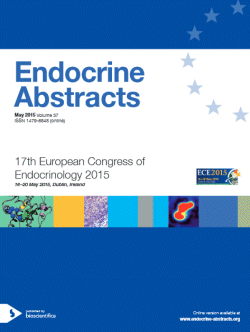Oral Communications
Adrenal 1
ea0037oc1.1 | Adrenal 1 | ECE2015
PRKACA defects and cortisol-producing lesions of the adrenal cortex: specific clinical phenotypes and histological features
Angelousi Anna , Salpea Paraskevi , Faucz Fabio , Zilbermint Michail , London Edra , Libe Rossella , Espiard Stephanie , Lyssikatos Charalampos , Kelestimur Fahrettin , Kebebew Electron , Delemer Brigitte , Hieronimus Sylvie , Feve Bruno , Raverot Gerald , Bertherat Jerome , Stratakis Constantine
ea0037oc1.2 | Adrenal 1 | ECE2015
Functional study of ARMC5 (armadillo repeat containing 5), a new tumour suppressor gene involved in primary bilateral macronodular adrenal hyperplasia
Drougat ludivine , Espiard Stephanie , Doly Stephane , Rodriguez Stephanie , Rizk-Rabin Marthe , Libe Rossella , Assie Guillaume , Marullo Stefano , Ragazzon Bruno , Bertherat Jerome
ea0037oc1.3 | Adrenal 1 | ECE2015
[123/131I] azetidinylamide a novel radiotracer for diagnosis and treatment of adrenocortical tumours -- from bench to bedside
Hahner Stefanie , Heinze Britta , Herrmann Ken , Buck Andreas K , Blumel Christina , Hanscheid Heribert , Brumberg Joachim , Michelmann David , Nannen Lukas , Ries Martin , Fassnacht Martin , Allolio Bruno , Schirbel Andreas
ea0037oc1.4 | Adrenal 1 | ECE2015
11C-metomidate PET-CT in primary aldosteronism: five possible indications for a non-invasive alternative to adrenal vein sampling
Powlson Andrew S , Koulouri Olympia , Azizan Elena , Maniero Carmela , Taylor Kevin , Aigbirhio Franklin , Koo Brendan , Cheow Heok K , Buscombe John , Gurnell Mark , Brown Morris J
ea0037oc1.5 | Adrenal 1 | ECE2015
Norepinephrine transporter as a predictive marker of response to PI3K/mTOR inhibition in phaeochromocytoma
Lee Misu , Laitinen Iina , Braren Rickmer , Pellegata Natalia S




